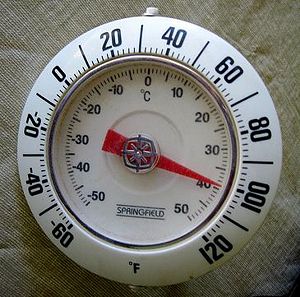Fahrenheit (unit): Difference between revisions
imported>Daniel Mietchen (#REDIRECT Fahrenheit and Rankine temperatures) |
imported>Daniel Mietchen (pasted in from http://en.citizendium.org/wiki?title=Fahrenheit_and_Rankine_temperatures&oldid=100608182) |
||
| Line 1: | Line 1: | ||
{{subpages}} | |||
{{Image|Thermometer Dial.jpg|right|300px|A thermometer dial displaying temperatures in degrees Celsius and in degrees Fahrenheit.}} | |||
The '''Fahrenheit''' scale is a [[temperature]] scale named after the [[German]] physicist [[Daniel Gabriel Fahrenheit]] (1686 − 1736), who proposed it in 1724. The symbol of a degree Fahrenheit is '''°F''' and the scale has now been largely replaced by the [[Celsius]] scale although it is still in use for non-scientific purposes in the [[United States]]. | |||
In the Fahrenheit scale, the [[melting point]] of [[water]] (i.e., ice) at an atmospheric [[pressure]] of 101.325 [[kilo|k]][[Pascal (unit)|Pa]] is 32 degrees Fahrenheit (°F) and the [[normal boiling point]] of water is 212 °F, placing those two reference points exactly 180 °F apart. [[Absolute zero]] in the Fahrenheit scale is −459.67 °F. | |||
For comparison, in the Celsius scale, the melting point of water is 0 degrees Celsius (°F) and the normal boiling point of water is 100 °C, placing those two reference points exactly 100 °C apart. Absolute zero in the Celsius scale is 273.15 °C. | |||
A temperature interval of 1 degree Celsius is equal to an interval of 1.8 degrees Fahrenheit. | |||
Revision as of 17:43, 12 December 2009
The Fahrenheit scale is a temperature scale named after the German physicist Daniel Gabriel Fahrenheit (1686 − 1736), who proposed it in 1724. The symbol of a degree Fahrenheit is °F and the scale has now been largely replaced by the Celsius scale although it is still in use for non-scientific purposes in the United States.
In the Fahrenheit scale, the melting point of water (i.e., ice) at an atmospheric pressure of 101.325 kPa is 32 degrees Fahrenheit (°F) and the normal boiling point of water is 212 °F, placing those two reference points exactly 180 °F apart. Absolute zero in the Fahrenheit scale is −459.67 °F.
For comparison, in the Celsius scale, the melting point of water is 0 degrees Celsius (°F) and the normal boiling point of water is 100 °C, placing those two reference points exactly 100 °C apart. Absolute zero in the Celsius scale is 273.15 °C.
A temperature interval of 1 degree Celsius is equal to an interval of 1.8 degrees Fahrenheit.
